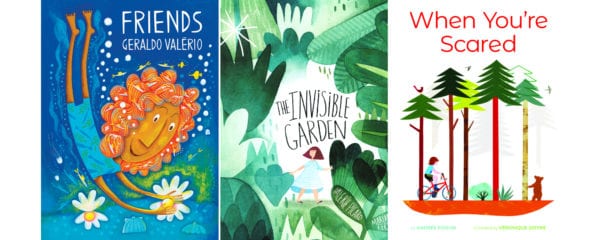
In 2012, a library of the best “silent books” was created on the Italian island of Lampedusa for refugee children from the Middle East and Africa. Without seeing its holdings list, one would think it includes minimalist classics like Raymond Briggs’s The Snowman, Peggy Rathmann’s Good Night, Gorilla, Barbara Lehman’s The Red Book, Alexandra Day’s series of Carl books, David Wiesner’s Flotsam, and Jerry Pinkney’s The Lion & the Mouse. The value of wordless or minimally worded picture books goes beyond the fact that, unshackled by language, they can aspire to a certain universality. Studies have shown that silent books promote discussion, visual literacy, and multiple interpretations in different ways from text-based books. They’re also uniquely empowering for pre-readers, who can bring their own style, and logic, to the storytelling role.
Geraldo Valério’s wordless Friends begins with a girl and her frog companion standing on a beach. As the friends dip their fingers in the water, curious fish approach them, which gives the girl the idea to get her fishing tackle and catch one. But the fish, realizing this is no longer a fun game, take off. Their own plans scuttled, frog and girl invent a new game mugging and waving at their reflections (which also brings the fish back). The girl’s reflection soon takes on a life of its own but possessed of a mermaid’s bottom half. The reflection beckons the girl to enter the water and the two float around, intertwined, collecting pearls to wear as necklaces. Valério’s caricature-ish illustrations (the girls’ giant, elongated heads sit on narrow, rubbery bodies) achieve their impact with a bold, split-complementary colour scheme – our girl is orange, her marine partner all blues and greens. It’s unquestionably ebullient, yet the unwavering approach is also the story’s weak spot: the full-bleed pages eventually start to feel a bit monotonous, both in terms of colour and the activities depicted. The images ultimately feel less like a story than a series of snapshots.
In Valérie Picard’s The Invisible Garden, illustrator Marianne Ferrer demonstrates the power of a limited palette – her beautiful watercolours employ subtle blues, purples, greens, and ochres — especially when paired with an innovative use of white space and splashes of bold colour to draw the eye. The minimally worded story shows a young girl, Arianne, enthusiastically arriving at her grandmother’s birthday in the country only to become quickly bored — the “party” is just adults, talking. Someone suggests Arianne might be happier in the garden; and after lying down there, she finds herself embarking on an unusual journey.
Suddenly tiny, she pursues oversized grasshoppers and dragonflies, using a dandelion as a parasail. The top of a mountain breaks off and becomes a skipping stone, which draws her into the ocean’s depths. Now she’s riding a dinosaur-like creature out of the water, in a kind of evolutionary re-enactment, and catching stars with a butterfly net. The book’s reverie-like logic comes from the soon-to-be revealed fact that it is all a dream; while you can question the likelihood of a girl this age so readily – and conveniently – falling asleep outdoors, there’s no doubting the fluid charm of her story.
Andrée Poulin’s When You’re Scared, set at a North American campground, is the most successful of these three books. Though not wordless, it’s based around iterations of a single, short phrase: “He’s a little scared.” This mantra is initially shown on a panel of a boy building up the courage to jump into the water and then to describe a bear cub that has fallen into a dumpster. Mutual fears collide when the boy, sent to dispose of a bag of garbage, discovers the trapped cub and its anxious mother. After the boy runs back to his own mother, the two devise an elegant solution: they put a tree trunk in the dumpster so the cub can crawl out. The story ends with nocturnal scenes of the humans and their ursine counterparts separately gazing at a slivered moon and the declaration: “They’re no longer scared.”
Véronique Joffre’s retro, two-dimensional, collage-based illustrations are wonderfully vibrant in their infographic stylings. They also play artfully with perspective as we move from the dumpster’s dark, suffocating interior to a bright, bird’s-eye view of the campground (where we spy the bears walking in the distance).
Not every picture in these books will be worth a thousand words, but each has the power to unlock a conversation about why that is, or isn’t, the case.
 Contact us via email
Contact us via email

